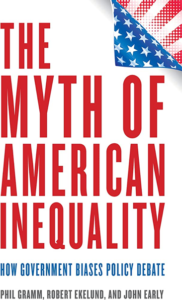Book Review by Myra Salzer
 Lately, I’ve been challenging myself to explore multiple perspectives on commonly held beliefs. As such, I was attracted to the book: The Myth of American Inequality – how government biases policy debate by Phil Gramm, Robert Ekelund, and John Early. I’ve been hearing for years and years how the middle class is disappearing, how the poverty rate is going up, and how the majority of financial resources of the American population are held only in the hands of the few ultrarich. This book utilizes statistics to convincingly challenge many of those beliefs.
Lately, I’ve been challenging myself to explore multiple perspectives on commonly held beliefs. As such, I was attracted to the book: The Myth of American Inequality – how government biases policy debate by Phil Gramm, Robert Ekelund, and John Early. I’ve been hearing for years and years how the middle class is disappearing, how the poverty rate is going up, and how the majority of financial resources of the American population are held only in the hands of the few ultrarich. This book utilizes statistics to convincingly challenge many of those beliefs.
One of the biggest statistical biases used by the government is its very definition of poverty and wealth. If you include government transfers such as food stamps, childcare credits, and income taxes paid, true income inequality results indicate the disparity between the top quintile and the lowest quintile is really a fraction of that reported by the Census. The “official” measure of poverty does not include two-thirds of all payments to recipients. If all transfer payments were to be included in the calculation, the 2017 poverty rate plummets from a reported 12.3% to a minimal 2.5%. In fact, in 2017 the bottom earning 20% of households received more than $45,000 in government transfer payments. A point made much later in the book is that this is a disincentive to getting educated or employed. It’s hard to argue with that!
Households in the top 20% of income earners lose 35.2% of their pretax income to taxes of all kinds compared to the bottom 20% of income earners who are only taxed at a rate of 7.5%. While I’m 100% in support of a graduated income-tax bracket structure, ignoring its existence to perpetuate a myth of inequality is not helpful when creating policies to overcome a problem that may not be such a problem after all.
Another big misleading statistic is that the Census Bureau measures its statistics by counting households, with no adjustments made for household size. On a per capita basis, the top quantile is only 2.2 times as much income per person living in the household as the bottom quintile – a considerably smaller difference than the 4.0 times as much without any adjustment for household size. So, a household with a single full-time college student living on student loans gets the same weighting as a household consisting of two middle age professionals in their peak earning years, and the same as a family of six with a single wage earner.
Several years ago, the highway between Boulder and Denver was under construction and getting enlarged. The two-lane highway was enlarged AND a third HOV/toll lane was added. The system was an improvement for everybody, yet there was grousing about how the HOV/toll lane discriminated because poor people couldn’t afford to pay the toll. The new system improved the experience of traveling from Boulder to Denver for everyone. The two free lanes were improved, and poor people also had the option of carpooling in the HOV lane at no charge. The tide rose for everyone. You wouldn’t have thought that was the case, listening only to the vociferous, consistent “victims of unfairness.”
The Myth of American Inequality points out how much better all of our lives are than we are made to believe. From the number of color TVs and flush toilets to the improvements in technology and the effects of Moore’s law (that the speed and capabilities of tech doubles every two years), all of our lives are better and easier. In fact, an average lower-income person in 2017 will live eight years longer than the top-quintile person did in 1967. Good points!
One critique on length… the 264-page book could have been significantly shortened and still communicated effectively with the reader. I read the same, repetitive statistics presented in multiple, slightly different ways. Fifty percent of the statistics could have been deleted without any diminishment of the message.
Overall, a very interesting and enlightening read. It takes courage to write optimistically when, IMHO, Americans seem to clamor to find something to complain about.